Abstract
1. Agonist-antagonist interactions at acetylcholine (ACh) muscarinic receptors have been analysed by use of an improved urinary bladder assay, isolated and intact, from the mouse. With 5-methylfurmethide as agonist, validated cumulative concentration-effect curves were obtained in less than 7 min by re-dosing before the response plateaux began to fade. 2. The pKB value estimated for pirenzepine was 6.76. The pKB values estimated for atropine and N-methylatropine from data obtained at concentrations which produced dose-ratios greater than 20 and 60 were 8.90 and 9.58, respectively. 3. The deviation from simple competitive behaviour at low dose-ratios with atropine and N-methylatropine was consistent with the operation of saturable antagonist removal processes. The deviation observed with atropine was corrected by pre-incubation with methylbutyrate, an alternative substrate for 'atropine esterase'. 4. The simple competitive behaviour of N-methylatropine was restored following pre-incubation with the neuronal choline uptake blocker hemicholinium-3 (HC-3). However, the pKB estimated for N-methylatropine under these conditions was low. This latter result could be accounted for by the observed behaviour of HC-3 as a competitive antagonist of ACh muscarinic receptors (pKB = 4.01). 5. We conclude that the modified mouse urinary bladder assay is suitable for the quantitative analysis of muscarinic receptor interactions. In addition, we postulate the existence of a previously undescribed uptake mechanism for quaternary muscarinic receptor antagonists.
Full text
PDF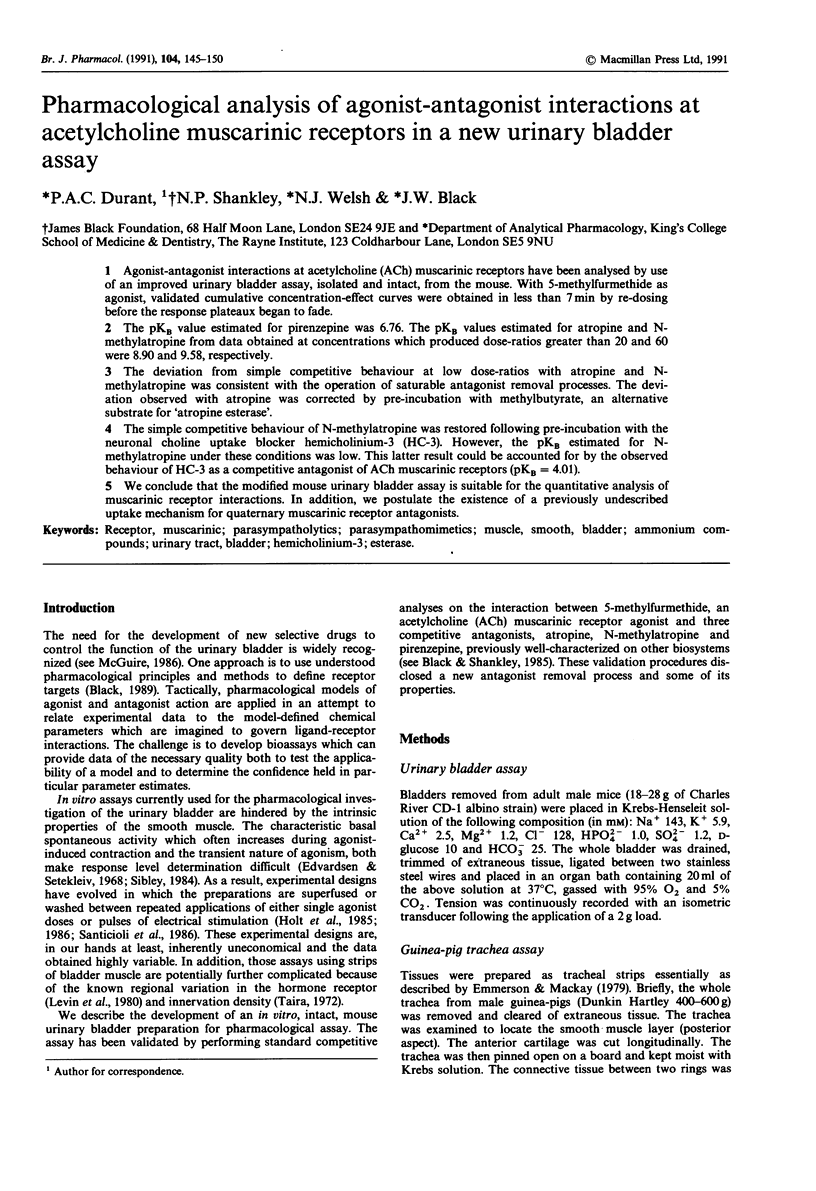
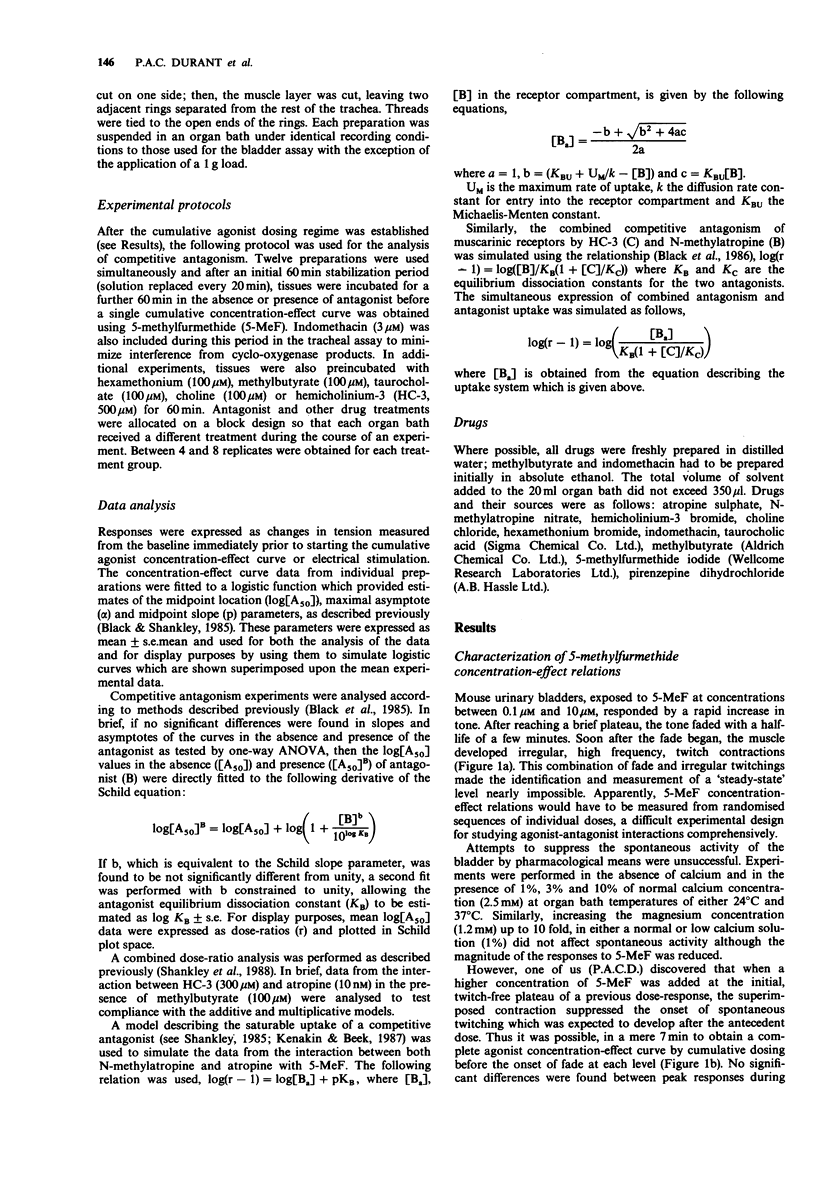

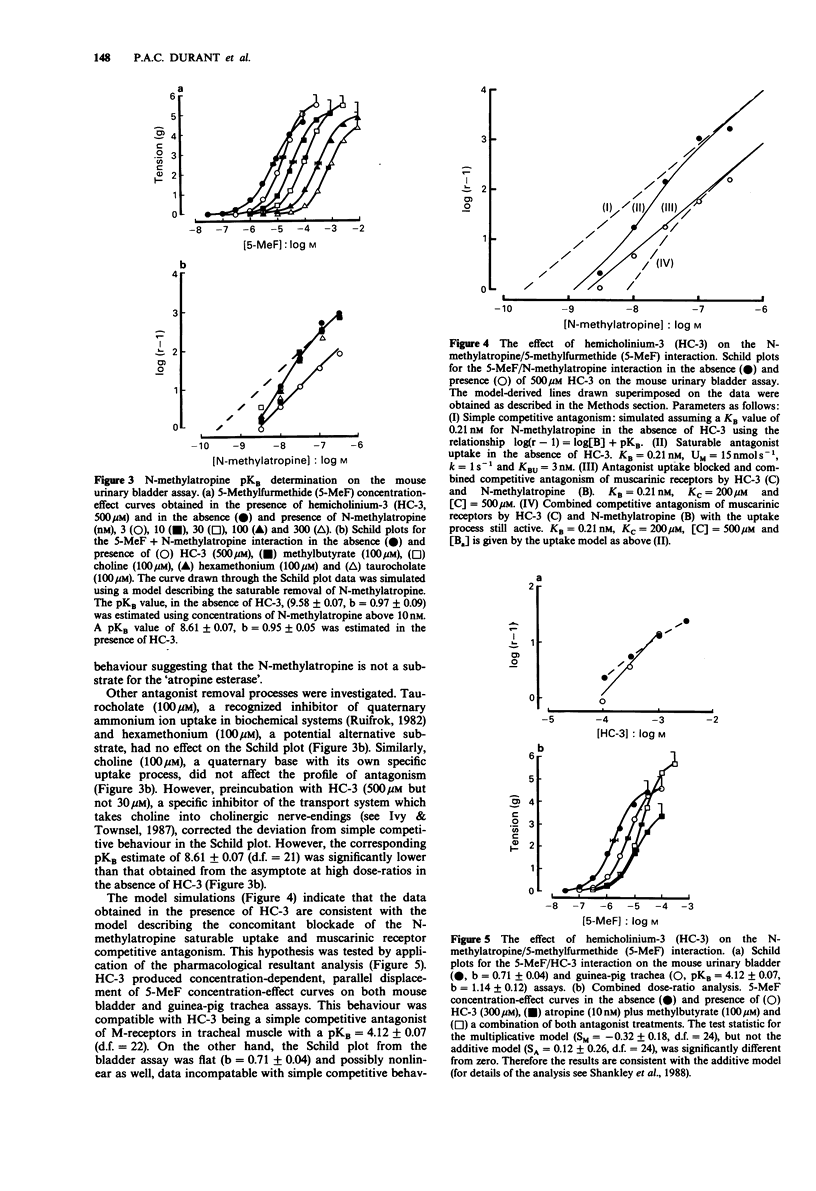
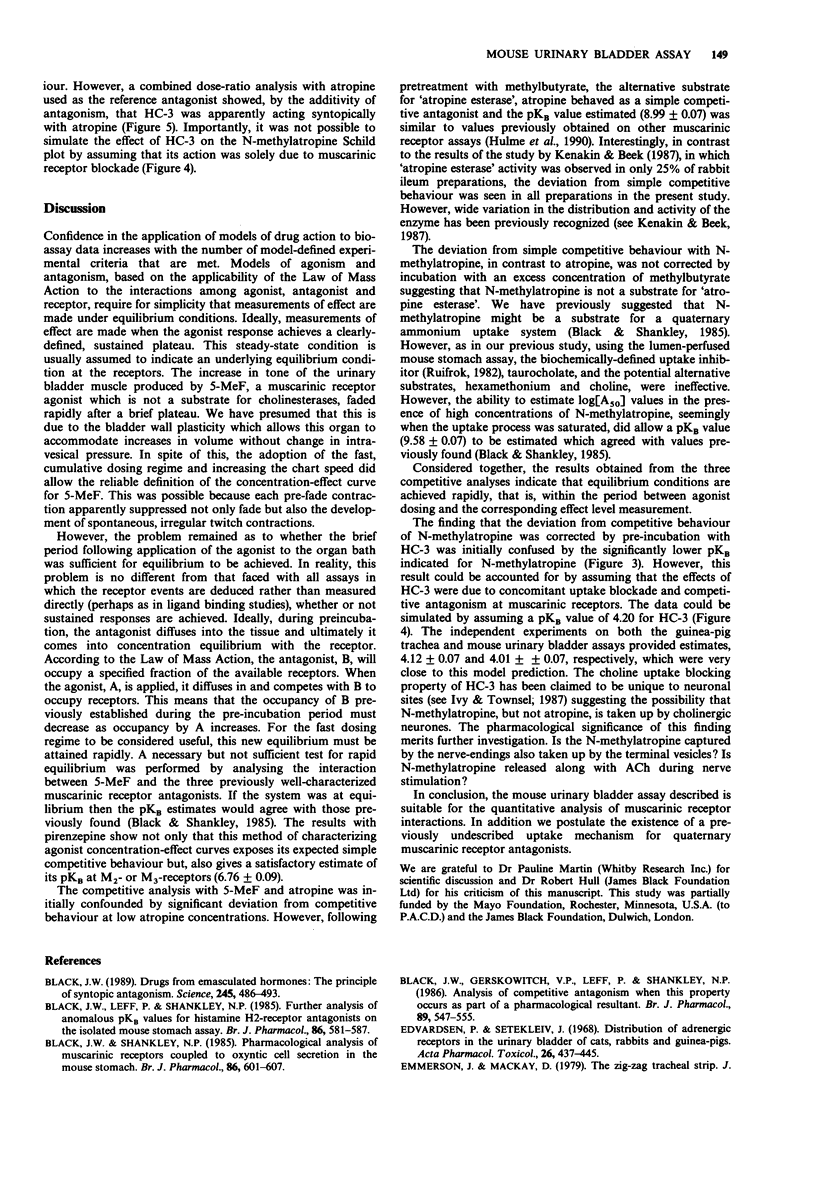
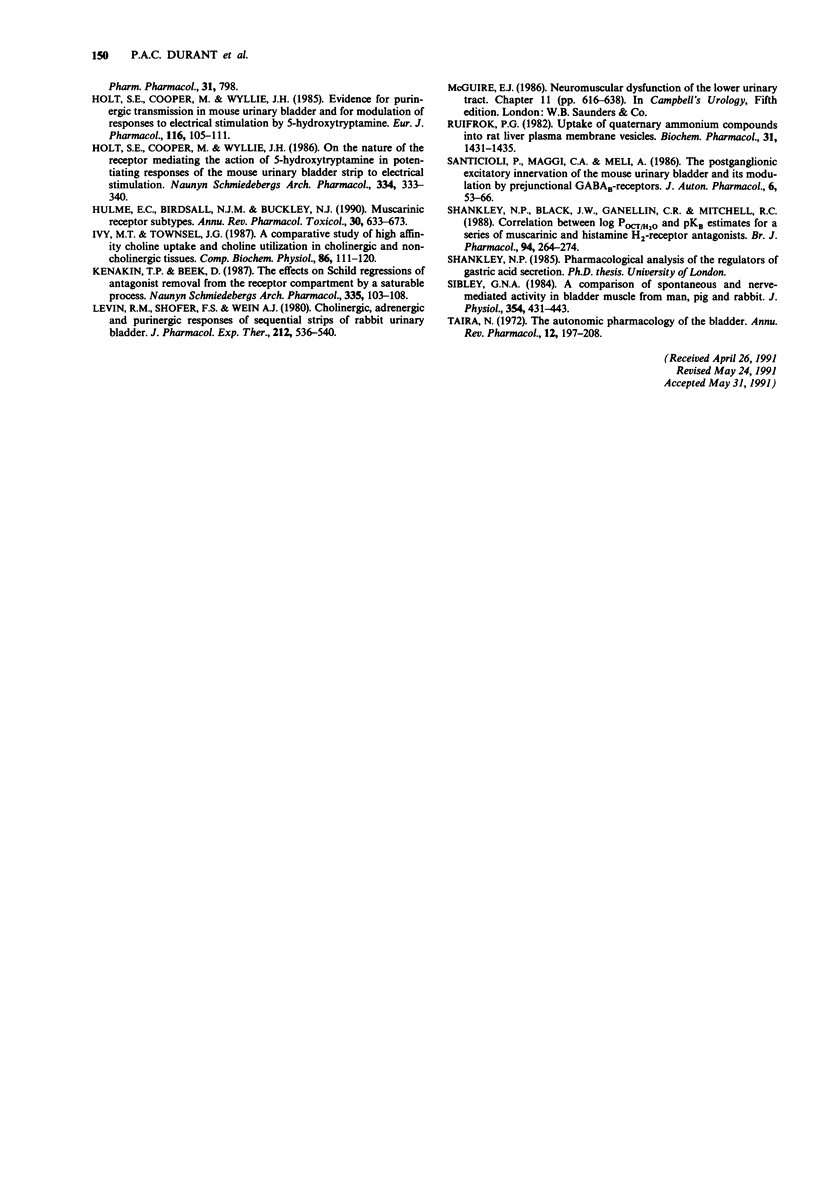
Selected References
These references are in PubMed. This may not be the complete list of references from this article.
- Black J. W., Gerskowitch V. P., Leff P., Shankley N. P. Analysis of competitive antagonism when this property occurs as part of a pharmacological resultant. Br J Pharmacol. 1986 Nov;89(3):547–555. doi: 10.1111/j.1476-5381.1986.tb11155.x. [DOI] [PMC free article] [PubMed] [Google Scholar]
- Black J. W., Leff P., Shankley N. P. Further analysis of anomalous pKB values for histamine H2-receptor antagonists on the mouse isolated stomach assay. Br J Pharmacol. 1985 Nov;86(3):581–587. doi: 10.1111/j.1476-5381.1985.tb08934.x. [DOI] [PMC free article] [PubMed] [Google Scholar]
- Black J. W., Shankley N. P. Pharmacological analysis of muscarinic receptors coupled to oxyntic cell secretion in the mouse stomach. Br J Pharmacol. 1985 Nov;86(3):601–607. doi: 10.1111/j.1476-5381.1985.tb08936.x. [DOI] [PMC free article] [PubMed] [Google Scholar]
- Black J. Drugs from emasculated hormones: the principle of syntopic antagonism. Science. 1989 Aug 4;245(4917):486–493. doi: 10.1126/science.2569237. [DOI] [PubMed] [Google Scholar]
- Edvardsen P., Setekleiv J. Distribution of adrenergic receptors in the urinary bladder of cats, rabbits, and guinea-pigs. Acta Pharmacol Toxicol (Copenh) 1968;26(5):437–445. doi: 10.1111/j.1600-0773.1968.tb00462.x. [DOI] [PubMed] [Google Scholar]
- Emmerson J., Mackay D. The zig-zag tracheal strip. J Pharm Pharmacol. 1979 Nov;31(11):798–798. doi: 10.1111/j.2042-7158.1979.tb13666.x. [DOI] [PubMed] [Google Scholar]
- Holt S. E., Cooper M., Wyllie J. H. Evidence for purinergic transmission in mouse bladder and for modulation of responses to electrical stimulation by 5-hydroxytryptamine. Eur J Pharmacol. 1985 Oct 8;116(1-2):105–111. doi: 10.1016/0014-2999(85)90190-6. [DOI] [PubMed] [Google Scholar]
- Holt S. E., Cooper M., Wyllie J. H. On the nature of the receptor mediating the action of 5-hydroxytryptamine in potentiating responses of the mouse urinary bladder strip to electrical stimulation. Naunyn Schmiedebergs Arch Pharmacol. 1986 Dec;334(4):333–340. doi: 10.1007/BF00569366. [DOI] [PubMed] [Google Scholar]
- Hulme E. C., Birdsall N. J., Buckley N. J. Muscarinic receptor subtypes. Annu Rev Pharmacol Toxicol. 1990;30:633–673. doi: 10.1146/annurev.pa.30.040190.003221. [DOI] [PubMed] [Google Scholar]
- Ivy M. T., Townsel J. G. A comparative study of high affinity choline uptake and choline utilization in cholinergic and non-cholinergic tissues. Comp Biochem Physiol C. 1987;86(1):111–120. doi: 10.1016/0742-8413(87)90152-6. [DOI] [PubMed] [Google Scholar]
- Kenakin T. P., Beek D. The effects on Schild regressions of antagonist removal from the receptor compartment by a saturable process. Naunyn Schmiedebergs Arch Pharmacol. 1987 Feb;335(2):103–108. doi: 10.1007/BF00177709. [DOI] [PubMed] [Google Scholar]
- Levin R. M., Shofer F. S., Wein A. J. Cholinergic, adrenergic and purinergic response of sequential strips of rabbit urinary bladder. J Pharmacol Exp Ther. 1980 Mar;212(3):536–540. [PubMed] [Google Scholar]
- Ruifrok P. G. Uptake of quaternary ammonium compounds into rat liver plasma membrane vesicles. Biochem Pharmacol. 1982 Apr 1;31(7):1431–1435. doi: 10.1016/0006-2952(82)90039-9. [DOI] [PubMed] [Google Scholar]
- Santicioli P., Maggi C. A., Meli A. The postganglionic excitatory innervation of the mouse urinary bladder and its modulation by prejunctional GABAB receptors. J Auton Pharmacol. 1986 Mar;6(1):53–66. doi: 10.1111/j.1474-8673.1986.tb00631.x. [DOI] [PubMed] [Google Scholar]
- Shankley N. P., Black J. W., Ganellin C. R., Mitchell R. C. Correlation between log POCT/H2O and pKB estimates for a series of muscarinic and histamine H2-receptor antagonists. Br J Pharmacol. 1988 May;94(1):264–274. doi: 10.1111/j.1476-5381.1988.tb11523.x. [DOI] [PMC free article] [PubMed] [Google Scholar]
- Sibley G. N. A comparison of spontaneous and nerve-mediated activity in bladder muscle from man, pig and rabbit. J Physiol. 1984 Sep;354:431–443. doi: 10.1113/jphysiol.1984.sp015386. [DOI] [PMC free article] [PubMed] [Google Scholar]
- Taira N. The autonomic pharmacology of the bladder. Annu Rev Pharmacol. 1972;12:197–208. doi: 10.1146/annurev.pa.12.040172.001213. [DOI] [PubMed] [Google Scholar]


